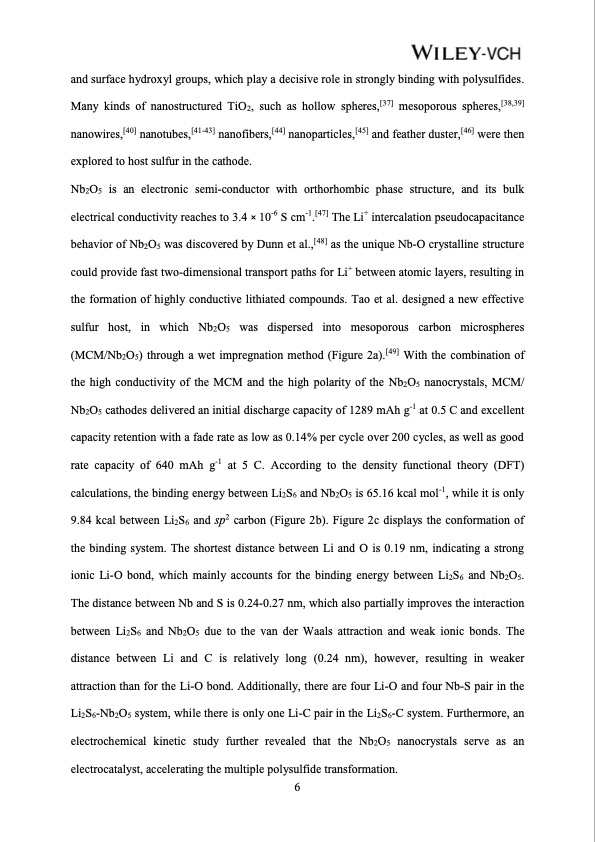
PDF Publication Title:
Text from PDF Page: 008
and surface hydroxyl groups, which play a decisive role in strongly binding with polysulfides. Many kinds of nanostructured TiO2, such as hollow spheres,[37] mesoporous spheres,[38,39] nanowires,[40] nanotubes,[41-43] nanofibers,[44] nanoparticles,[45] and feather duster,[46] were then explored to host sulfur in the cathode. Nb2O5 is an electronic semi-conductor with orthorhombic phase structure, and its bulk electrical conductivity reaches to 3.4 × 10-6 S cm-1.[47] The Li+ intercalation pseudocapacitance behavior of Nb2O5 was discovered by Dunn et al.,[48] as the unique Nb-O crystalline structure could provide fast two-dimensional transport paths for Li+ between atomic layers, resulting in the formation of highly conductive lithiated compounds. Tao et al. designed a new effective sulfur host, in which Nb2O5 was dispersed into mesoporous carbon microspheres (MCM/Nb2O5) through a wet impregnation method (Figure 2a).[49] With the combination of the high conductivity of the MCM and the high polarity of the Nb2O5 nanocrystals, MCM/ Nb2O5 cathodes delivered an initial discharge capacity of 1289 mAh g-1 at 0.5 C and excellent capacity retention with a fade rate as low as 0.14% per cycle over 200 cycles, as well as good rate capacity of 640 mAh g-1 at 5 C. According to the density functional theory (DFT) calculations, the binding energy between Li2S6 and Nb2O5 is 65.16 kcal mol-1, while it is only 9.84 kcal between Li2S6 and sp2 carbon (Figure 2b). Figure 2c displays the conformation of the binding system. The shortest distance between Li and O is 0.19 nm, indicating a strong ionic Li-O bond, which mainly accounts for the binding energy between Li2S6 and Nb2O5. The distance between Nb and S is 0.24-0.27 nm, which also partially improves the interaction between Li2S6 and Nb2O5 due to the van der Waals attraction and weak ionic bonds. The distance between Li and C is relatively long (0.24 nm), however, resulting in weaker attraction than for the Li-O bond. Additionally, there are four Li-O and four Nb-S pair in the Li2S6-Nb2O5 system, while there is only one Li-C pair in the Li2S6-C system. Furthermore, an electrochemical kinetic study further revealed that the Nb2O5 nanocrystals serve as an electrocatalyst, accelerating the multiple polysulfide transformation. 6PDF Image | Advances in Polar Materials for Lithium-Sulfur Batteries

PDF Search Title:
Advances in Polar Materials for Lithium-Sulfur BatteriesOriginal File Name Searched:
212718644.pdfDIY PDF Search: Google It | Yahoo | Bing
Sulfur Deposition on Carbon Nanofibers using Supercritical CO2 Sulfur Deposition on Carbon Nanofibers using Supercritical CO2. Gamma sulfur also known as mother of pearl sulfur and nacreous sulfur... More Info
CO2 Organic Rankine Cycle Experimenter Platform The supercritical CO2 phase change system is both a heat pump and organic rankine cycle which can be used for those purposes and as a supercritical extractor for advanced subcritical and supercritical extraction technology. Uses include producing nanoparticles, precious metal CO2 extraction, lithium battery recycling, and other applications... More Info
| CONTACT TEL: 608-238-6001 Email: greg@infinityturbine.com | RSS | AMP |